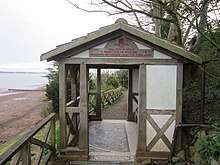Bowness-on-Solway
Bowness-on-Solway is a village of fewer than 100 houses in northwest Cumbria, situated to the west of Carlisle on the southern (English) side of the Solway Firth estuary separating England and Scotland. The civil parish had a population of 1,126 at the 2011 census.[1] The western end of Hadrian's Wall is a notable tourist destination, though the Wall itself is no longer to be seen here above ground. The west end of the Hadrian's Wall Path is marked by a pavilion on the small coastal cliff at Bowness. Other attractions are the beaches and wading birds.
| Bowness-on-Solway | |
|---|---|
 St. Michael's Church, Bowness-on-Solway | |
 Bowness-on-Solway Location within Cumbria | |
| Population | 1,126 (2011) |
| OS grid reference | NY220623 |
| Civil parish |
|
| District | |
| Shire county | |
| Region | |
| Country | England |
| Sovereign state | United Kingdom |
| Post town | WIGTON |
| Postcode district | CA7 |
| Dialling code | 01697 |
| Police | Cumbria |
| Fire | Cumbria |
| Ambulance | North West |
| UK Parliament | |
The village is part of the Solway Coast Area of Outstanding Natural Beauty.
Etymology
'Bowness' means 'rounded', or bow-shaped headland', from either the Old English 'boga', 'bow', and 'næss', or, more probably, the Old Norse 'bogi' and 'nes'.[2]
Roman era
The village is situated on the site of the Roman fort called Maia, the second largest on Hadrian's Wall.[3] There was also a small civilian settlement (vicus) outside the south gate of this fort.[3]
Governance
Bowness-on-Solway is part of the parliamentary constituency of Workington. In the December 2019 general election, the Tory candidate for Workington, Mark Jenkinson, was elected the MP, overturning a 9.4 per cent Labour majority from the 2017 election to eject shadow environment secretary Sue Hayman by a margin of 4,136 votes.[4] Until the December 2019 general election The Labour Party has won the seat in the constituency in every general election since 1979.The Conservative Party has only been elected once in Workington since World War 2, at the 1976 by-election.[5]
Before Brexit, it was in the North West England European Parliamentary Constituency.
St Michael's Church
Built atop what may be the granary for the Roman fort in the 12th century, the two original bells were stolen by border raiders in 1626, accidentally dropping them in the Solway during their flight. In retaliation, the villagers raided Dornock and Middlebie in Scotland, making off with a new pair of bells. Traditionally, on inception, the vicar of Annan petitions the village's neighbours for the return of his bells.
Solway Viaduct
In 1869, the Solway Junction Railway was opened, connecting the Maryport and Carlisle Railway to the Scottish railway system more directly than the existing route through Carlisle, by a 1 mile (2 kilometres), 176-yard (161 m) iron girder viaduct (the remains of which can still be seen) across the Solway between Bowness-on-Solway and Annan in Scotland.[6] The construction of the viaduct prevented ships entering the upper Solway and hence destroyed the trade of Port Carlisle, which had already been largely supplanted by the construction of a wet dock at Silloth. The viaduct suffered minor frost damage in 1875; in 1881 large sections of it were destroyed by ice floes, but the viaduct was rebuilt. The railway never lived up to its promoters' expectations, and in 1914 it was restricted to carrying goods only. In 1921 the railway was closed entirely, and in 1934 the viaduct was demolished.
Gallery
 Bowness main street
Bowness main street Pavilion at the west end of the Hadrian's Wall Path
Pavilion at the west end of the Hadrian's Wall Path Remains of Solway viaduct - English side 2018
Remains of Solway viaduct - English side 2018_1868182_c14d22bb.jpg) The station building in 1961
The station building in 1961 Lindow Hall, Bowness
Lindow Hall, Bowness
References
- "Parish population 2011". Retrieved 18 June 2015.
- Armstrong, A. M.; Mawer, A.; Stenton, F. M.; Dickens, B. (1950). The place-names of Cumberland. English Place-Name Society, vol.xx. Part 1. Cambridge: Cambridge University Press. p. 123.
- Maia at www.Roman-Britain.org Archived 2011-06-07 at the Wayback Machine
- "Workington parliamentary constituency – Election 2019".
- "A vision of Britain website – general elections section". Retrieved 27 April 2012.
- http://www.visitcumbria.com/car/solway-junction-railway/
External links
| Wikimedia Commons has media related to Bowness-on-Solway. |
- Cumbria County History Trust: Bowness-on-Solway (nb: provisional research only - see Talk page)
- VisitCumbria
- TheCumbriaDirectory